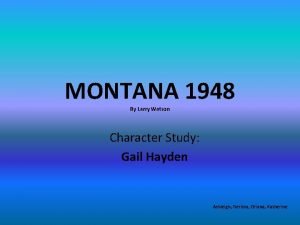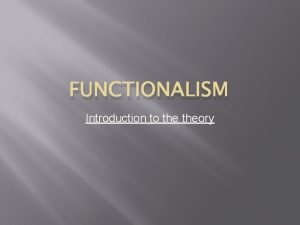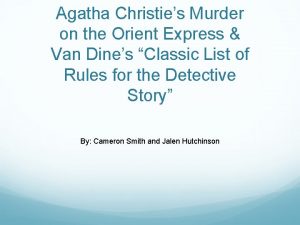Murder on the Orient Express Analysis Project Gail













- Slides: 13

Murder on the Orient Express Analysis Project Gail Kelly and Mason Riggs

That Means What? • Avail- Use or take advantage of (an opportunity or available resource) • Credo- A statement of the beliefs or aims that guide someone's actions • Concocter- To devise using skill or intelligence • Lovelorn- Bereft of love or someone’s lover • Hymeneal- A wedding song or poem • Latter- Being the second of persons mentioned • Pother- A commotion or disturbance

That Means What? • Metaphysics- The branch of philosophy that examines the nature of reality, including the relationship between mind and matter, substance and attribute, fact and value • Onus- A difficult or disagreeable responsibility or necessity, a burden or obligation • Culpability- Deserving of blame or censure as being wrong, evil, improper, or injurious • Delineation- To draw or trace the outline, sketch out • Verisimilitude- The quality of appearing to be true or real

The Guidelines for a Detective Story 1. The reader should have the possibility of solving the crime from the clues stated in the book. 2. The only one who can deceive is the criminal himself. 3. The detective can’t have a love interest. 4. The detective can’t be the criminal. 5. The detective must figure out the crime not by chance, or luck. 6. The story must include a detective who is good at his job.

The Guidelines for a Detective Story 7. There must be a murder for the detective to solve. 8. The ways for solving the crime must be natural, and not paranormal. 9. There can only be one detective. 10. The criminal must be someone who has played a rule in the story. 11. The criminal must be someone who you never expect. 12. There is only one criminal. 13. The criminal did not commit the crime because he is a secret society or mafia.

The Guidelines for a Detective Story. 14. The reason for the killing must make sense. 15. The murderer of the crime must be so noticeable that he is noticeable. 16. The story shouldn’t go outside of the murder. 17. The criminal should never feel guilty for his crime. 18. The crime can never be an accident. 19. The motive for the crime should be personal. 20. The crime will always be solved by wits, and not some out of the blue conclusion.

Rule Number 15 “The Classic List of Rules for the Detective Story” “ 15. The truth of the problem must at all times be apparent- provided the reader is shrewd enough to see it. By this I mean is that if the reader, after learning the explanation for the crime, should re-read the book, he would see that the solution had, in a since, be staring him in the face-that all the clues really pointed to the culpritand that, if he had been as clever as the detective, he would have solved the mystery himself without going on to the final chapter. That the clever reader does often thus solve the problem goes without saying” ( Van Dine). Explanation: Through out the Agatha Christie’s novel, The Murder on the Orient Express, she uses lots of subtle foreshadowing. The first time you read the book, you may not pick up on the foreshadowing, however if you were to re-read the book you would see so clearly who the murders really were. Murder on the Orient Express: “I have known for some time. It is so clear that I wonder you have not seen it also”(Christie 230).

Rule Number 7 “The Classic List of Rules for the Detective Story” “ 7. There simply must be a corpse in a detective novel, and the deader the corpse the better. No lesser crime than murder will suffice. Three hundred pages is far too much pother for a crime other than murder. After all, the reader’s trouble and expenditure of energy must be rewarded”(Van Dine). Explanation: The novel follows clearly with this rule. The entire story is rapped around the murder of Ratchett. The murder even occurs on the train creating more suspense for the readers. Murder on the Orient Express: “And now a passenger lies dead in his berth-stabbed”(Christie 39).

Rule Number 5 “The Classic List of Rules for the Detective Story” “ 5. The culprit must be determined by logical deductions-not by accidents or coincidence or unmotivated confession. To solve a criminal problem in this latter fashion is like sending the reader on a deliberate wild-goose chase, and then telling him, after he has failed, that you had the object of his search up your sleeve all the time. Such an author is no better than a practical joker”( Van Dine). Explanation: An entire third of the book is all about Poirot thinking through the evidence that he has found through out the story. He slowly starts to put the pieces together and deciphers who is innocent and who is guilty. Murder on the Orient Express: “We are cut off from the normal routes of procedure. Are these people whose evidence we have taken speaking the truth, or lying? We have no means of finding out-except such means as we can devise our selves. It is an exercise, this, of the brain”(Christie 182).

Rule Number 19 “The Classic List of Rules for the Detective Story” “ 19. The motives for all crimes in detective stories should be personal. International plottings and war politics belong in a different category of fiction-in secret-service tales, for instance. But a murder story must be kept gemutlich, so to speak. It must reflect the reader’s everyday experiences, and give him a certain outlet for his own repressed desires and emotions”(Van Dine). Explanation: Soon after the murder Poirot discovers that Ratchett was connected to the Armstrong case and who ever killed him knew of his former identity. His killer wanted to seek revenge for the death he has caused and the murder he committed in the Armstrong family. Murder on the Orient Express: “Ratchett had escaped justice in America. There was no question as to his guilt. I visualized a self-appointed jury of twelve people who had condemned him to death and who by the exigencies of the case had them selves been forced to be his executioners”(Christie 239).

Rule Number 10 “The Classic List of Rules for the Detective Story” “ 10. The culprit must turn out to be a person who has played a more or less prominent part in the story-that is, a person with whom the reader is familiar and in whom he takes an interest”(Van Dine). Explanation: At the conclusion of the novel, you figure out that even the people that you never expected to be the murderer, were in fact guilty as well. Murder on the Orient Express: “I came to a vary odd conclusion. I came to the conclusion that the person who had taken no part in the crime was the person who would be considered the most likely to do so”(Christie 242).

Answer the Question We believe that for the most part the novel fits the guidelines for Van Dine’s idea of a good mystery novel. It includes someone that you expect but was always in front of you, if you reread the novel you would be able to find the clues that lead to who murderer was, and Poirot discovered who the murderer was with logic and not luck. Over all Murder on the Orient Express fits the guidelines for a good mystery novel.

Works Cited Christie, Agatha. Murder on the Orient Express. Toronto: Bantam, 1983. Print. Van Dine, S. S. ""Twenty Rules for Writing Detective Stories"" American Magazine Sept. 1928: n. pag. Web.
 Murder on the orient express vocabulary
Murder on the orient express vocabulary Murder on the orient express analysis
Murder on the orient express analysis Teakfa orient étkezőkocsi
Teakfa orient étkezőkocsi Orient ezan cihazı
Orient ezan cihazı Lensatic compass diagram
Lensatic compass diagram Orient a map using a lensatic compass
Orient a map using a lensatic compass Elalog
Elalog Orient east med corridor
Orient east med corridor Orient east med corridor
Orient east med corridor Orient east med corridor
Orient east med corridor Organic analogy parsons
Organic analogy parsons Montana 1948 gail
Montana 1948 gail Parsons gail model
Parsons gail model Dr. gail cheramie
Dr. gail cheramie























